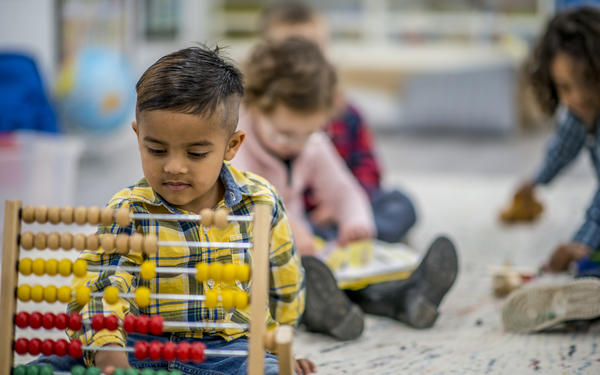Education is the answer to social inclusion and opportunities for refugee children
This article first appeared in leading Qatari daily newspaper Al Sharq in July 2022.

The number of children around the world displaced as a result of war, famine, floods or other disasters is growing at an unprecedented rate. According to data from UNICEF, the global number of child refugees under the UNHCR mandate grew from four million to around 10 million between 2005 and 2020. The situation became progressively worse between 2010 and 2020, as the number of child refugees increased by 116%.
Fast forward to 2022, and we are witnessing how the ongoing war in Ukraine is making the situation even more grim. Apart from the physical and mental toll, one of the immense casualties of war is the disruption to education. Nearly 7.5 million children in Ukraine are facing huge interruptions to their education, as an average of 22 schools come under attack every day.
Protecting the right to education for refugee children
Reintegrating refugee children into society and protecting their right to education is fundamental. Sadly, many children are simply no longer able to learn as a result of lack of resources, language barriers, unfamiliar entrance exams, poor funding and heavily impacted wellbeing. Despite calls for aid and a global commitment to give these children a second chance – they continue to struggle with access to the necessary foundations for learning.
If vulnerable children can continue their education, they will be more likely to be able to live independently, be financially self-reliant and contribute to their communities in the future. Policymakers must recognise this and come together to make this vision a reality for millions of refugee children.
In Qatar, the Qatar Fund for Development (QFFD) in cooperation with the Education Above All Foundation has signed agreements to provide quality education for out of school children, through EAA’s Educate a Child programme. The programme aims to provide access to education for more than 1.6 million out of school children and youth by developing educational curricula, improving educational techniques and methods, and improving infrastructure for schools and classrooms, among others. At present, it covers Somalia, Sierra Leone, Tanzania, Pakistan, South Sudan and Haiti. Not all the children supported by the programme are refugees, but they have been identified as those hardest to reach – often due to barriers like extreme poverty, conflict and climate change.
At Cambridge Partnership for Education, we have worked closely with UNICEF to develop an education programme for Rohingya refugee children in Bangladesh which aims to help them re-integrate into a national education system when this is possible. Cambridge is also working to assist this transition in Europe by mapping the Ukrainian curriculum to the education systems of countries receiving refugees, starting with mathematics. These maps can be provided to teachers to help them understand where their new Ukrainian students may be on their learning journeys, compared to their own students.
We need more initiatives like these if we are to give vulnerable and refugee children their best chance at the bright future they deserve. The global community, including businesses, governments and donors must come together to offer long-term, evidence-based education initiatives and teacher support to deliver them.
Empowering students to transition to a suitable education curriculum
The most pressing concern today is the mental and physical wellbeing of displaced children. Many of these children have fled their homes unaccompanied, and all could be experiencing trauma and health concerns. Protecting their childhood is a priority. Their wellbeing is also a prerequisite to continuing education and equipping them with the skills they need for the future.
If children’s basic needs are not met, such as their physiological and safety needs, they will not be able to learn even if they have access to school and resources. Teachers too need support to help teach children experiencing trauma. Cambridge English is creating online communities for Ukrainian teachers, with daily support for those teaching in challenging circumstances.
And, even once children’s basic needs are met, currently, refugees are grappling with lack of access to quality materials, including textbooks, online resources and examinations that allow for progression. We must ensure that learners living through conflict have the necessary access to well-constructed and sensitively designed textbooks.
To truly re-integrate them into society, vulnerable children may need access to learning materials that plant the seeds of hope, with a clear path to a stable future. What if lesson plans and learning materials were designed to encourage collaboration as children solve problems on a range of issues like environmental sustainability, cultural understanding or conflict resolution? Cambridge and UNICEF have explored possibilities to embed peacebuilding in Mathematics education in South Sudan – where children have only known severe violence.
Education for peacebuilding
There is a lot of global outrage about the plight of refugee children; but this is not enough. We need greater collaboration to enable a smooth transition for this displaced generation. This is a cross-industry effort.
At the Doha Forum, the UNHCR High Commissioner for Refugees, Filippo Grandi, discussed the importance of education for those displaced by conflict and its role in contributing to reconciliation and dialogue.
According to the UNHCR, long-term refugees have the opportunity to acquire skills in areas such as leadership, advocacy, mediation and conflict resolution, which can be invaluable in contributing to the rebuilding of their communities if and when they return to their home countries. Continued education for refugee children will be fundamental in driving peacebuilding work and social re-integration for the future.
Read in Al Sharq
This article first appeared in Qatari daily newspaper Al Sharq in July 2022.
This article first appeared in Qatari daily newspaper Al Sharq in July 2022.
